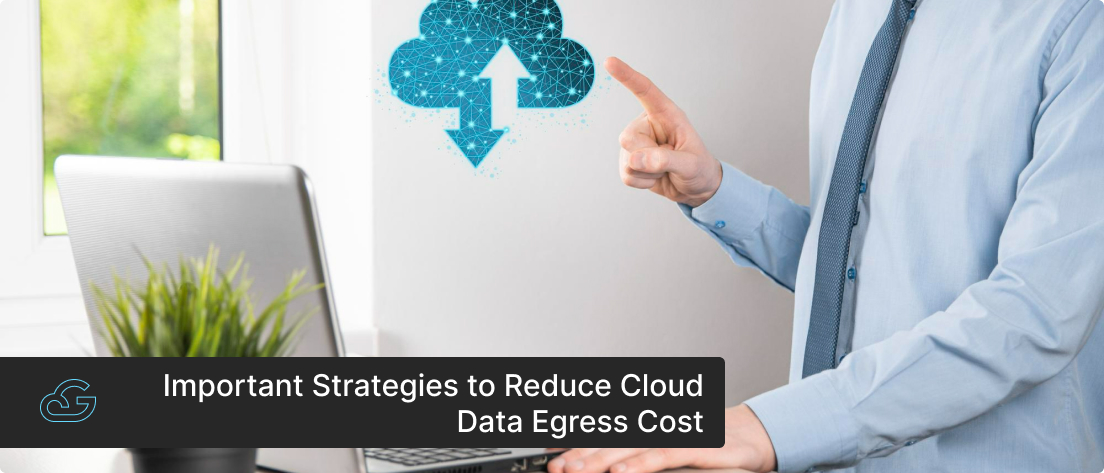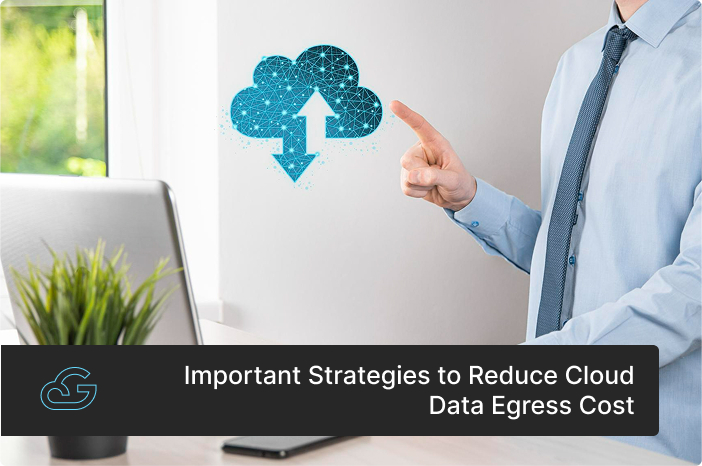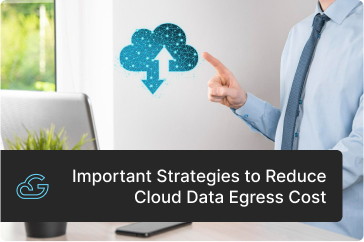Blogs / Cost Optimization
Important Strategies to Reduce Cloud Data Egress Cost
By
Sibin Vincent
Posted: March 6, 2025
• 6 Minutes
Did you get a real shock when reviewing this month’s cloud bill? Are the numbers way more than what you initially forecasted before migrating to the cloud? The reason behind it could be something called “cloud data egress”.
Data egress charges can be categorized as one of the hidden costs that come along with cloud computing. Typically, when you hear about hidden costs in the cloud, you might think of over-provisioned resources, under-utilized virtual machines, or idle storage buckets. However, data egress charges are different. They occur mainly due to the way cloud service providers structure data transfer costs within their service offerings.
As you know already, cloud service providers offer various resources, from storage buckets and virtual machines to fully managed platforms. These resources allow your business to rapidly scale and innovate. But to enable data movement (especially when data exits their network), cloud service providers must invest in additional infrastructure such as fiber cables, switches, routers, etc. The associated costs are passed on to you as data egress fees.
While this is justifiable from the service providers’ point of view, users like you may feel skeptical about moving to the cloud. But there is no reason to worry. Even though cloud data egress fees can drive up your total cloud bill, there are proven strategies to keep them under control.
In this blog post, we will break down what cloud data egress is, why it occurs, and more importantly, how you can minimize its financial impact.
What is Cloud Data Egress and Data Egress Costs
Cloud data egress refers to the movement of data from a cloud computing environment to another location. This new location could be:
- The public internet
- Your company’s on-prem data center
- Same cloud provider’s data center in a different region
- Same cloud provider’s data center in a different availability zone (AZ)
- Another virtual network within the same data center
- A new cloud service provider’s data center
All these data movements will end up creating data egress charges. This is known as "data egress costs in the cloud".
However, cloud providers often offer free usage thresholds, and fees vary based on the service model. For instance, in AWS EC2 instances, the first 100 GB of data egress to public internet is free. Once this threshold is crossed, subsequent data transfers will cost from USD 0.0900 to USD 0.0500 per GB, depending on volume.
Now, you must be wondering—what about data that is coming into cloud computing environments? Would that also incur additional charges? This type of data movement is called “data ingress”. The good news is that the fees for it are extremely minimal and normally consolidated into the total service charges.
If you are running workloads on the cloud, it is important to understand data egress costs and the driving factors behind them. Because these costs can negatively impact your overall cloud budget, hamper IT innovation and organizational growth, disrupt your cost efficiency, and much more. Therefore, to create and incorporate effective strategies, you must first uncover factors that lead to egress costs. Let’s look at each one of them individually.
Key Factors That Contribute to Cloud Data Egress Costs
- Volume: The volume of data that you are transferring out of the cloud has a major influence on your egress costs. Most cloud providers follow a tiered pricing model where the first few gigabytes are free or comparatively cheap. However, as the volume increases, the cost will also go up proportionally. Businesses that involve large-scale data analytics or media streaming workloads experience huge egress charges due to the large amount of data being transferred out of their cloud networks.
- Frequency: The frequency at which you transfer data from cloud environments has an impact on egress costs. That is when compared to the cost of a one-time bulk data transfer, the cost of frequent smaller transfers will accumulate into a huge figure over time, resulting in an inflated bill. Real-life examples of this can be seen with workloads such as real-time analytics, applications that operate across different regions, etc.
- Destination: Just like volume and frequency, where you are transferring data can influence data egress costs. Moving data to the public internet, another cloud provider or an on-prem data center is usually more expensive than transferring it within the same cloud provider’s ecosystem. For example, AWS S3 egress cost is lower for intra-region transfers compared to transfers to external networks. However, you must remember that even within the same cloud provider, cross-region or cross-availability-zone transfers can still incur charges, making it crucial to plan data movement carefully.
- Methods: The methods used to transfer data can impact egress costs. Downloading data over the public internet is typically more expensive than using private links or dedicated cloud networking solutions like AWS Direct Connect, Azure ExpressRoute, or Google Cloud Interconnect. Additionally, protocol choices (e.g., FTP vs. HTTP, streaming vs. batch processing) and data compression techniques can influence the total cost of data egress.
These are some of the major factors that can increase your cloud data egress costs. Let’s now move on and examine some of the effective strategies that you can deploy to keep these costs under control.
Effective Strategies to Reduce Cloud Data Egress Costs
-
Utilize A Content Delivery Network (CDN):
A CDN can scan your website’s static assets like images and files and cache
them at edge servers close to the users. This way, when the user loads a
website or makes a request, these static assets are pulled from the CDN instead
of cloud-hosted servers, thereby reducing cloud data egress costs and minimizing
the load time.
However, you must note that CDNs also come with their own bandwidth costs and might require minor modifications to your application or website code. Therefore, you must carefully analyze their pricing policies as well.
-
Compress Transferred Data & Network Traffic:
By using delta encoding techniques or compression algorithms like Gzip, bzip2, or Brotli, you can remove
redundancies and minimize the amount of data that is transferred. As
the volume of data getting transmitted reduces, your cloud data egress
costs will also come down substantially.
Like compressing the transferred data, you can also try to compress the network traffic. Even though this is difficult to accomplish in networks that communicate with public internet or data centers, you can implement it for infrastructure traffic. For instance, in VM-to-VM communication over a virtual network, you can compress the network traffic by slightly increasing the CPU usage cycles. Even though this enhanced CPU usage will incur some costs, they are significantly lower than egress charges.
-
Leverage Data Transfer Pools:
Some cloud providers offer data transfer pools, which allow multiple services
(virtual machines, storage buckets, load balancers, etc.) within the same
account to share a combined data transfer allowance. Instead of each service
having its own separate limit—where unused free transfer capacity goes
to waste—data transfer pools let you distribute that free allowance across
different workloads.
For example, if one service doesn’t use its full free data transfer quota, another service can utilize the remaining capacity, helping to reduce overall egress costs. This can be especially useful for businesses running multiple cloud services that frequently move data within the same cloud provider’s ecosystem.
However, not all cloud providers offer this feature, and the rules may vary depending on the provider and service type. If your cloud provider supports pooled data transfer, leveraging it can help optimize costs and prevent unnecessary egress fees.
-
Use Cloud-Provider Tools:
All major cloud service providers offer tools that can help you optimize
data transfers. These tools use techniques like optimized routing and caching
and have built-in acceleration protocols, which reduce both egress costs
and transfer times.
A popular example is the S3 Transfer Acceleration (S3TA) tool from AWS that speeds up data transfers to and from S3 buckets. It works by caching data at the AWS edge location and harnessing streamlined network paths. This can be particularly beneficial when moving large datasets over long distances, as it can reduce latency and, in some cases, lower transfer costs.
-
Establish a Dedicated Private Network Connection:
Another strategy that you can employ for reducing cloud data egress costs
is setting up a private network connection. This enables you to bypass
the public internet and form a secure and reliable high-bandwidth connection
to your cloud provider.
Even though private connections can come with higher initial costs, they can lead to significant long-term savings for businesses with heavy data transfer needs. All major cloud providers offer dedicated private links, such as AWS Direct Connect, Azure ExpressRoute, and Google Cloud Interconnect, which help optimize costs and improve performance.
- Limit Data Transfers to A Fixed Region: While this strategy may not always be feasible, structuring your workflows to minimize cross-region data transfers can significantly reduce egress costs. Cloud providers typically charge higher fees for moving data between regions compared to intra-region transfers. By keeping data transfers within the same geographic region, you can take advantage of lower rates and avoid unnecessary expenses. This approach works particularly well for applications with regional user bases or workloads that don’t require multi-region availability.
Implementing these strategies might require major changes to your application architecture and infrastructure configurations. However, the potential cost savings can make your efforts worthwhile. On top of these strategies, there are certain best practices that you must follow for cost-effective cloud data transfer. Let’s take a look at them.
Best Practices for Cost Effective Cloud Data Transfer
- Monitor and Audit Cloud Data Transfer: Keep a close watch on your cloud data movements and conduct regular audits by using tools like AWS Cost Explorer or Azure Cost Management. These tools allow you to track egress costs and identify data transfer patterns, helping you uncover inefficiencies or anomalies. This way, you can make sure that your data egress costs are streamlined.
- Facilitate Cloud Resource Tagging: Tagging cloud resources with their respective costs can help promote accountability and make cost tracking highly effective. With accurate tagging, you can trace data egress costs back to specific departments, projects, or applications, making it easier to implement targeted optimizations.
- Set Budget Alerts: Setting budget alerts is a simple yet highly effective way to ensure you don’t overspend on cloud data transfers. Cloud providers, such as AWS, Azure, and Google Cloud, allow users to set custom budgets for specific services or accounts. Once a threshold is exceeded, you will receive notifications to keep track of your spending.
- Enforce Data Segmentation and Prioritization: Some data transfers are more important or urgent than others, and prioritizing these can help you optimize costs. By segmenting your data and understanding its business value, you can ensure that only essential data is being moved. This strategy helps reduce unnecessary transfers, lowering overall egress costs.
- Schedule Off-Hour Data Transfers: Cloud service providers often adjust their pricing based on demand, with lower rates during off-peak hours when network traffic is lower. Scheduling data transfers during these times can help take advantage of these discounts and reduce egress costs.
Reduce Data Egress Charges with Gsoft’s Cost Optimization Strategies
Minimizing cloud data egress costs is not easy. The strategies that we have laid down in this blog post are extremely complex. To implement them effectively, a strong understanding of cloud computing, data management, and IT infrastructure is essential.
This is where we come in. As a cloud cost optimization service provider, we have a wealth of knowledge and hands-on experience executing cost optimization strategies specially tailored toward reducing data egress costs. Through our cost-optimization services, we ensure that our clients achieve maximum cost-efficiency without having to compromise their performance and IT security.
Here’s what you will get with Gsoft:
- Data Transfer Optimization
- Tailored Cost Reduction Strategies
- Advanced Network Solutions
- Strategic Use of Cloud-Provider Tools
- Optimized Data Routing with CDNs
- End-to-end support
Do you want to optimize your cloud data egress? Are you looking for a cloud partner with expertise in cost optimization? Book a consultation with our experts today at www.gsoftcomm.net/contact-us/ .


Get Know More About Our Services and Products
Reach to us if you have any queries on any of our products or Services.










